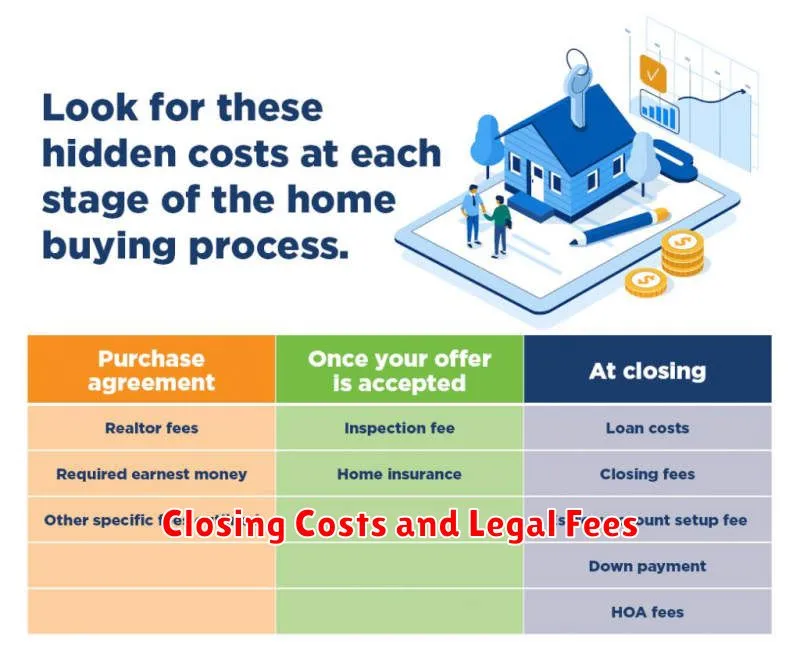Buying a house is a significant financial decision, often seen as a cornerstone of the American dream. While the excitement of homeownership is undeniable, it’s crucial to look beyond the listing price and understand the hidden costs that can significantly impact your budget. From closing costs and property taxes to homeowners insurance and potential maintenance expenses, unforeseen expenditures can quickly add up. This article delves into the often-overlooked hidden costs when buying a house, empowering you to make informed decisions and avoid financial surprises during and after the home buying process.
Navigating the complexities of the real estate market requires a comprehensive understanding of all associated expenses. Beyond the down payment and mortgage payments, a multitude of hidden costs can catch unprepared buyers off guard. Understanding these expenses is essential for accurate budgeting and ensuring a smooth transition into homeownership. We’ll explore these hidden costs when buying a house in detail, providing valuable insights into inspection fees, appraisal fees, moving costs, and other potential financial obligations that can arise throughout the purchasing process.
Why Budgeting Beyond the Sale Price Matters
When making a purchase, especially a large one, it’s crucial to budget beyond the sale price. Focusing solely on the sticker price can lead to unexpected expenses and financial strain. Many additional costs are often overlooked, such as taxes, fees, delivery charges, installation, and ongoing maintenance. For example, a new car purchase might include sales tax, registration fees, and potential maintenance costs like oil changes and tire replacements. Similarly, purchasing a home involves closing costs, property taxes, insurance, and potential repair expenses.
Failing to account for these extra costs can significantly impact your finances. It can lead to exceeding your budget, accumulating debt, or delaying other important financial goals. Proper budgeting involves researching and anticipating all potential expenses associated with a purchase. This allows for informed decision-making and helps avoid unpleasant financial surprises. It’s also important to consider the long-term costs of ownership, especially for durable goods. This includes factors like energy consumption, repair frequency, and potential replacement costs down the line.
By considering the complete cost of ownership, you can make more responsible financial decisions. This approach ensures you’re prepared for all expenses associated with your purchase, leading to greater financial stability and peace of mind. Taking the time to research and plan beyond the initial sale price will ultimately lead to a more positive and sustainable financial outcome.
Home Inspection Fees
Home inspection fees vary based on several factors, including the size, age, and location of the property, as well as the scope of the inspection. Additional services, such as radon testing or sewer scopes, will also influence the final cost. It’s crucial to obtain quotes from multiple inspectors to compare pricing and services offered.
While focusing solely on the lowest price might be tempting, prioritize inspectors with experience, certifications, and positive reviews. A thorough inspection can identify potential problems and save you significant money in the long run. Requesting a sample report can help you evaluate the inspector’s attention to detail and reporting style.
Remember that a home inspection is an investment in your future. Don’t hesitate to discuss the fee structure with potential inspectors and ask clarifying questions about what their services include. A clear understanding of the inspection process and associated costs will help you make an informed decision.
Closing Costs and Legal Fees

Closing costs are the expenses, beyond the property price, that buyers and sellers incur to finalize a real estate transaction. These costs can vary depending on the location, the lender, and the type of property being purchased. Common closing costs for buyers include lender fees, appraisal fees, title insurance, government recording fees, and escrow fees. Sellers often pay for real estate agent commissions, transfer taxes, and prorated property taxes.
Legal fees are a component of closing costs and represent the charges for legal services related to the transaction. Buyers and sellers may each choose to hire their own attorney to represent their interests. The attorney will review the purchase agreement, title documents, and other legal paperwork to ensure the transaction is legally sound and protect their client’s rights. Legal fees can vary based on the complexity of the transaction and the attorney’s hourly rate or fixed fee for such services.
It is crucial for both buyers and sellers to carefully review the closing costs and legal fees before finalizing the real estate transaction. Understanding these expenses will help avoid unexpected financial burdens and ensure a smooth closing process. Requesting a detailed closing disclosure from the lender and obtaining a clear fee structure from your attorney are essential steps in managing these costs effectively.
Mortgage Insurance Requirements
Mortgage insurance is typically required when a borrower makes a down payment of less than 20% of the home’s purchase price. This insurance protects the lender from potential losses if the borrower defaults on the loan. The primary purpose of mortgage insurance is to offset the lender’s increased risk associated with a high loan-to-value (LTV) ratio. Several types of mortgage insurance exist, including Private Mortgage Insurance (PMI) for conventional loans, and government-backed programs like FHA loans and VA loans, which have their own associated insurance premiums.
Several factors determine the cost of mortgage insurance, including the loan amount, the LTV ratio, the borrower’s credit score, and the type of loan. Generally, a larger loan amount, higher LTV ratio, and lower credit score will result in a higher mortgage insurance premium. It’s important to understand that mortgage insurance does not protect the borrower, but rather the lender. Borrowers should carefully evaluate the costs and benefits of mortgage insurance and explore options to minimize or eliminate this expense, such as making a larger down payment or exploring lender-paid mortgage insurance options.
Once a borrower reaches a certain amount of equity in their home, typically 20%, they can request to have the PMI cancelled. FHA loans and VA loans have different rules regarding mortgage insurance cancellation or termination. It’s crucial for borrowers to understand the specific requirements for their loan program to effectively manage this expense. Understanding these requirements will help borrowers minimize the overall cost of homeownership.
Property Taxes and Local Assessments

Property taxes are ad valorem taxes, meaning they are based on the assessed value of your property. Local governments, such as counties, cities, and school districts, levy these taxes to fund essential public services like schools, roads, and parks. The amount you owe depends on your property’s assessed value and the local tax rate, which varies by jurisdiction. It’s important to understand how your property’s assessed value is determined and to pay your property taxes on time to avoid penalties.
Local assessments are separate charges imposed on properties to pay for specific public improvements that directly benefit those properties. Common examples include street paving, sewer lines, and sidewalk repairs. Unlike property taxes, which are recurring annual expenses, assessments are typically one-time charges or spread out over a set period. These charges are usually based on the frontage of your property or the amount of benefit it receives from the improvement. While assessments can add to your overall property costs, they often increase property values by enhancing the neighborhood.
You can typically find information about your property taxes and local assessments by contacting your local tax assessor’s office or by checking their website. They can provide you with details about your property’s assessed value, the tax rate, and any applicable assessments. Understanding these charges is crucial for managing your property expenses effectively.
HOA Fees and Community Charges
HOA fees, or Homeowners Association fees, are recurring charges paid by homeowners in a planned community to cover the costs of shared amenities and services. These fees can vary significantly depending on the community and the services offered. Common expenses covered by HOA fees include landscaping, pool maintenance, snow removal, security, and general upkeep of common areas. Understanding the fees and what they cover is crucial before buying a property in an HOA community. Failure to pay HOA fees can result in liens against the property and even foreclosure.
The amount of HOA fees is typically determined by the HOA board and outlined in the community’s governing documents, such as the CC&Rs (Covenants, Conditions, and Restrictions). Fees can be assessed monthly, quarterly, or annually. Factors that influence the amount include the size and age of the community, the types of amenities offered, and the level of services provided. It’s important to budget for these fees as they are a significant part of homeownership costs in an HOA community.
In addition to regular HOA fees, communities may also levy special assessments for unexpected repairs or major projects. These assessments are typically one-time charges and can be substantial. Examples include roof replacements, road repairs, or upgrades to common facilities. Before buying in an HOA community, it is wise to inquire about the history of special assessments and the community’s reserve funds to understand the potential for future assessments.
Moving Costs and Initial Repairs
Moving can be a significant expense. Costs include transportation (truck rental, gas, or professional movers), packing supplies (boxes, tape, bubble wrap), and potentially temporary storage. Budget carefully and get multiple quotes from moving companies if using professional help. Consider the distance of the move as it greatly impacts the overall cost.
In addition to moving expenses, be prepared for potential initial repairs or improvements in your new home. These might include minor fixes like painting, patching holes, or deep cleaning. More substantial repairs, like plumbing or electrical work, should be addressed before moving in. Factor these costs into your budget to avoid financial surprises.
Creating a comprehensive checklist can be extremely helpful. This list should include all moving tasks and anticipated repairs, along with estimated costs. This will allow you to effectively track expenses and stay organized throughout the moving process. Remember to include a buffer for unexpected costs that may arise.
Utility Connection and Setup
Connecting utilities is a crucial step when moving into a new home or business. It involves coordinating with various service providers to establish essential services like electricity, gas, water, and internet. Contacting providers in advance is highly recommended to schedule connection or transfer dates that align with your move-in schedule. Be prepared to provide necessary information such as your service address, desired start date, and account details.
The connection process typically involves a technician visiting the property to activate services. Ensure clear access to meters and connection points. Be aware that fees may apply for connection, installation, or deposits, depending on the provider and your specific situation. It’s essential to confirm all costs beforehand to avoid any surprises. After the utilities are connected, test them thoroughly to confirm they are functioning correctly. Report any issues to the respective providers immediately.
Setting up your internet and communications services may require additional steps. Depending on your chosen provider and technology (DSL, cable, fiber), you may need to install equipment like a modem or router. Follow the provider’s instructions or contact their customer support for assistance. Testing your internet speed once connected is a good practice to ensure you’re receiving the advertised speeds. This can be done using various online speed test tools.
Ongoing Maintenance Expectations
Regular maintenance is essential for preserving the longevity and performance of any system. This involves routine checks, updates, and repairs to address potential issues before they escalate. Proactive maintenance not only minimizes downtime but also optimizes efficiency and reduces long-term costs. Tasks may include software updates, hardware inspections, and data backups, all crucial for ensuring smooth operation.
Establishing a consistent maintenance schedule is key. Depending on the specific system, this might involve daily, weekly, monthly, or annual checks. A well-defined schedule allows for predictable budgeting and resource allocation. Furthermore, thorough documentation of all maintenance activities is vital for tracking performance, identifying recurring problems, and facilitating future troubleshooting.
While preventative maintenance minimizes the likelihood of unexpected issues, a plan for handling emergencies is also necessary. This includes having a clear process for reporting problems, accessing technical support, and implementing temporary workarounds. Preparedness for unforeseen events ensures a swift and effective response, minimizing disruptions and maintaining business continuity.
Emergency Fund for Homeowners
An emergency fund is crucial for homeowners. Unexpected expenses, like a leaky roof, a broken appliance, or necessary landscaping work, can quickly arise and strain your finances. Having dedicated savings specifically for home-related emergencies can prevent you from accumulating debt or delaying essential repairs. Aim to save an amount equivalent to three to six months of your essential home expenses.
Determining how much to save involves calculating your regular housing costs. This includes your mortgage payments (including property taxes and insurance if part of your payment), utility bills, and any recurring maintenance fees. After tallying these, consider potential repair costs. While you cannot predict every expense, knowing the general cost of common repairs in your area can help you set a realistic savings goal.
Start building your fund gradually. Even small, regular contributions add up over time. Consider setting up automatic transfers to a separate savings account specifically designated for home emergencies. This makes saving consistent and helps you avoid dipping into the funds for non-emergency purposes. Review and adjust your savings goal annually to account for any changes in your housing costs.

